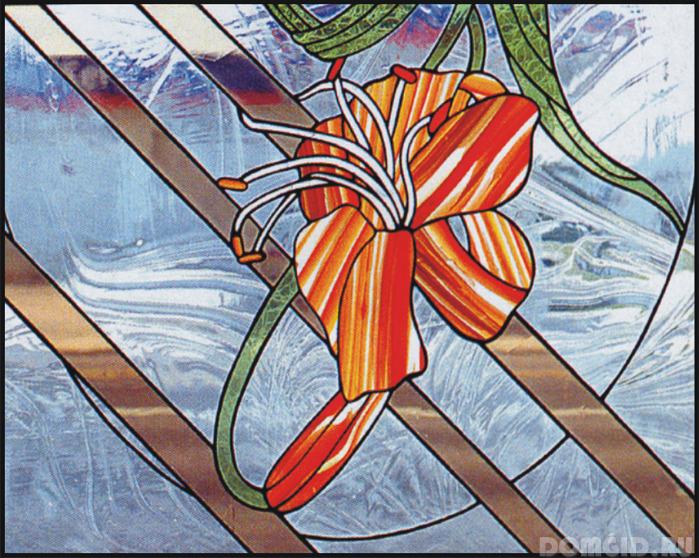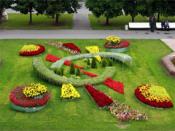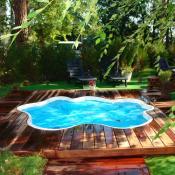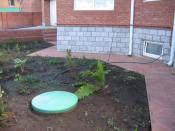Search
Login
Stained-glass windows in the interior of a modern house, making stained-glass windows with your own hands
You can transform the room, give it a perfect and attractive look by installing stained glass windows instead of ordinary glasses in window frames. Modern technologies for manufacturing stained-glass windows allow using them not only as window or door glasses, but also for creating original lamps, partitions and screens, ceilings, columns, bookcases. What is stained glass on glass and is it possible to make it with your own hands? It is about this, or rather about one of the rather simple and cheap manufacturing technologies that we will try to tell you in this article.
Content
- Is it possible to make classic stained-glass windows at home video
- Do-it-yourself stained glass windows and doors
- Cooking glass
- Select a picture and sketch
- Preparation of the mixture for the circuit video
- We carry out varnish filling video
Is it possible to make classic stained-glass windows at home

The history of the creation of stained-glass windows dates back more than one century, the traditional methods of manufacturing stained-glass windows are quite laborious, require special knowledge and skill, the sophisticated equipment used by masters in their manufacture excludes the possibility of using traditional technologies at home.
Expensive stained-glass windows in the past were used exclusively for decorating luxurious palaces and private houses of very wealthy people, churches, public buildings.
But today this amazingly beautiful form of art is becoming increasingly popular; it is used with pleasure when creating interiors of private houses or even city apartments.
Ready-made stained-glass windows, or made-to-order and in our times, have a considerable cost; copyright works are not available to everyone.
But make stained glass do it yourself it is possible to apply only specially designed simplified techniques, which however, in no way impair the decorative qualities of the products.
One of them is filling with varnishes. How to make colored varnish yourself is no secret.
Most often, the question arises when choosing a material for filling the contour, which serves as a dividing barrier between surfaces coated with varnishes of different colors.
In the manufacture of a classic stained-glass window, lead is used as such a protective element, the material is quite heavy.
Do-it-yourself stained glass windows and doors

To achieve a great effect in creating contours, you can use affordable and cheap materials, and the result is of such quality that you can even consider it at close range: the lines are light, distinct and fairly neat.
In addition, in a classic stained-glass window, drawing a picture only in the center of the glass surface is quite problematic, and this technology allows a simple solution to this problem.
The use of commercially available color films for the manufacture of stained-glass windows greatly limits the ability to use various shades, and the author’s creative ideas can be affected greatly.
Pouring technology allows you to use any shades - after all, paints are made by the contractor as necessary.
Cooking glass
The first step is to prepare the glass - you can take a new one, or you can turn the old one that was previously used for glazing a window or door, the ennobling of which is intended, into a stained glass window.
The glass is taken ordinary, you should not be afraid that its weight will increase significantly.
Glass is cleaned of dust, washed with special means for washing glass surfaces and wiped dry.
Select a picture and sketch

Before you start choosing a picture, you should look at the stained-glass windows in the photo - those that have a fairly simple and straightforward plot look more attractive and spectacular.
It should be clarified that one should not take themes from stained-glass windows made by someone, even if they are very successful.
It is best to choose a picture yourself, for this you can use postcards, illustrations from books, if you have skills, then drawings for stained-glass windows can be created independently.
It is most convenient to carry out work on the table.
We cover it with clean paper, mark the dimensions of the future stained-glass window and place the figure in the resulting plane.
We first draw its contours with a pencil, then with a felt-tip pen.
We lay the glass on paper over the finished sketch.
Preparation of the mixture for the circuit
We prepare the mixture for applying contours.
- In PVA glue, which is intended for bonding glass and porcelain surfaces, add black ink, about 1 part of the carcass to 2 parts of glue.
- We mix them until a homogeneous mass is obtained, gradually add the silverfish, until the shade reminds the color of lead. By the way, aluminum stained-glass windows can be made in the same way, only to add black mascara to the glue in a very small amount.

Obtained by mixing glue. silverfish and carcasses the composition will adhere tightly to the glass surface, have a volume and look very much like lead.
This composition allows you to apply lines of any thickness.
When drawing contour lines, the composition should be periodically mixed - the silver powder is light and can float to the surface.
Having stood for several hours after preparation, the composition may give different shades when applied, therefore, drawing on symmetrical fragments should be done simultaneously.
Contouring should be done with a soft brush.
Since the outline will share different shades of color, it should be made thickened.
The quality of the contour will subsequently depend on the attractiveness of the stained glass window.
We carry out varnish filling

For the preparation of varnish, NTs 222 and 2141 nitro-varnishes, solvent 646 or 647, and artistic oil paint can be used.
In finished form, the varnish should be so liquid that it spreads freely on the glass surface.
When working, varnishes can be mixed, the number of shades is unlimited.
Fill fragments with varnish using a large brush, while making sure that the varnish spreads evenly, filling the entire space near the contour.
Avoid air bubbles. Glass backlighting is not required during work.
If you have certain skills, you can try to make a gradient fill.
It will help to create three-dimensional images, but the production of stained-glass windows in this case will become a more time-consuming and lengthy process.

After the varnish has completely dried, re-applying the contour lines with a lead mixture will be required.
After making sure that the fill and the contour are completely dry, you should cover the entire surface of the stained-glass window alternately with three layers of colorless nitro varnish.





